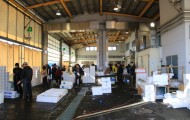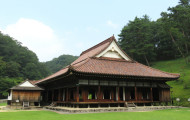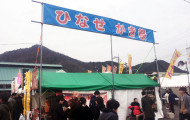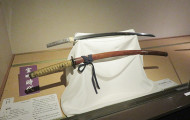History of Bizen Pottery
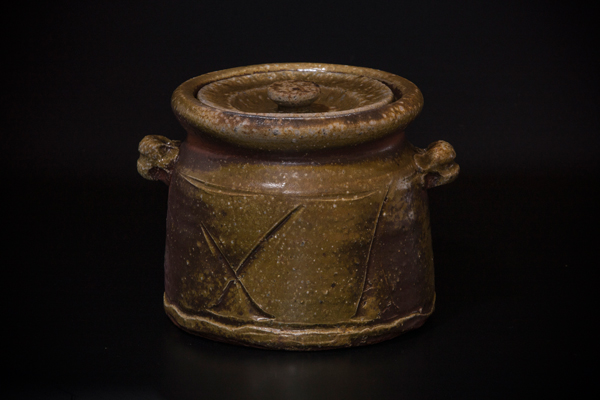
Its Roots can be Found in 6th Century Unglazed Wares
It is said that the origin of Bizen Pottery is found in the famed “Sueki earthenware vessels of the Oku region.”
It is said that Sueki earthenware were elaborate unglazed vessels that came to be made from technology that was transmitted to Japan from Korea in the period spanning the ‘Kofun’ (late 5th century), Nara and Heian periods.Because they were reduction fired at a high temperature exceeding 1000 degrees celcius in the anagama (cave kiln), they were generally grayish brown in colour.
The techniques used to make Sueki unglazed wares were transmitted to southeast Okayama prefecture around the middle of the 6th century. During this time, the kiln industry was centred around the town of Osafune in Oku (now Setouchi City) and not only were the wares used in that area, but they were also offered to the Imperial Court.
Kilns in the Latter Half of the Heian Period – The Early Stage of Bizen Pottery
Leading up to the latter half of the 12th century, kilns came to be constructed at the foot of the mountains that surrounded the villiage settlement of Imbe away from the Oku area.
The kiln ruins that first confirmed the presence of Bizen pottery were found at the foot of Mt. Koya and up in the mountains of Mt. Kuma.
The coastal area formed a strip for salt production that was blessed with fine weather and at a stretch of land in Osafune, the sword industry flourished from the latter Heian period. As a result, the scarcity of firewood intensified. Because of this, it is supposed that Sueki potters moved to Imbe in search of wood that would serve as fuel for their kilns.
What was made there were not artistic crafts like Sueki, but switched to pottery that was necessary for the daily lives of the populace. The improvement of popular living gave way to the birth of Bizen pottery.
Kilns in the Kamakura Period – Establishment Period of Bizen Pottery
There are two kiln ruins that have been excavated for investigation and have been identified as those used in the early period of Bizen pottery. These are the Guibigadani and Aigabuchi kiln ruins and are found halfway up in the mountains of Mt. Kuma.The kilns from back then were the Anagama that used the slope of the mountain, and wares of a dark grey complexion increased. Also, brownish coloured wares came to be mixed in among them.
At this stage where the production of wares was largely limited to containers, mortar bowls and jars, it can be said that Bizen pottery was established by the kilns of medieval period.
Kiln in Muromachi Period – Flourishing Period of Bizen Pottery
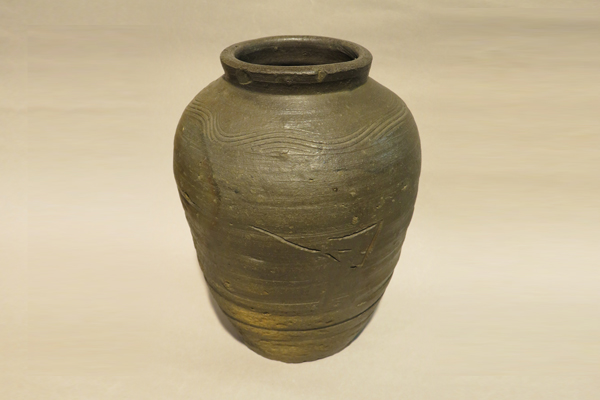
Old Bizen: Muromachi Wave Crest Jar (owned by Gallery Mugen-an)
As the years developed from the Kamakura period into the Muromachi period, Bizen pottery faced an age of unprecedented mass production and purchasing.The kilns that were once up in the mountains began to be moved further down, eventually reaching the foot of the mountains. As this happened, the mountain clay once used for Bizen pottery shifted to the use of clay from rice paddies also at the end of the Muromachi period.
Demand increased and so did popularity, meaning that when wares came to be loaded and sent off from the harbour, Kilns were gradually moved closer to the village for the convenient transportation of goods. As seen in the expression: “even if you throw a Bizen earthenware mortar, it isn’t ‘broken'”, practical Bizen Wares were fired in large quantities and eventually spread to various regions in Japan.
Giant Kilns in the Momoyama Period – Golden Age of Bizen Pottery
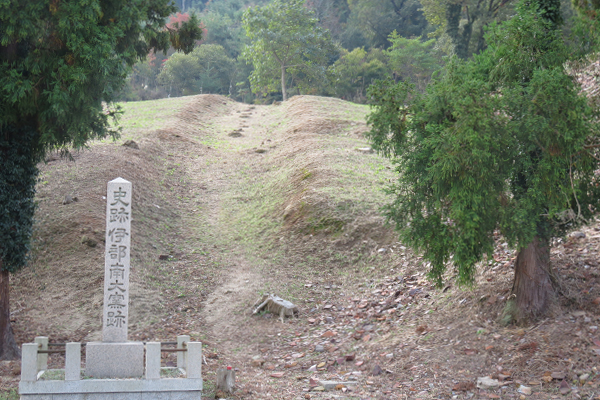
The Giant Southern Kiln (Minami-Ogama) ruins in Imbe.
After the mid-16th century, the kilns were unified to 3, namely, the Giant Southern, Northern and Western Kilns. Because it was a communal kiln, a maker’s mark was put on the works to easily identify whose it was. A maker’s mark was also a trademark for one’s own family.
Since the wares were fired in the giant kiln for about one month, there are some fascinating effects created by the Yohen.
The Giant Northern Kiln (Kita-Ogama) ruins in Imbe
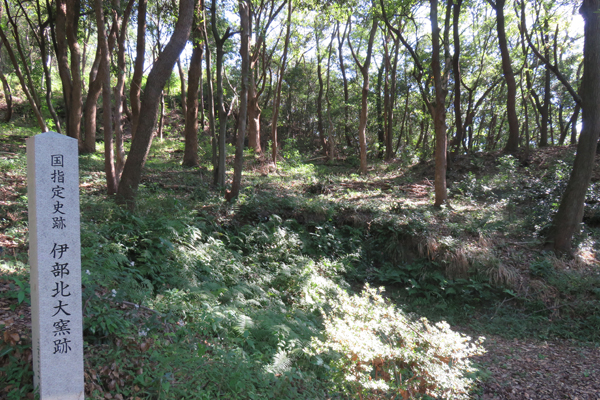
The Giant Western Kiln (Nishi-Ogama) ruins in Imbe
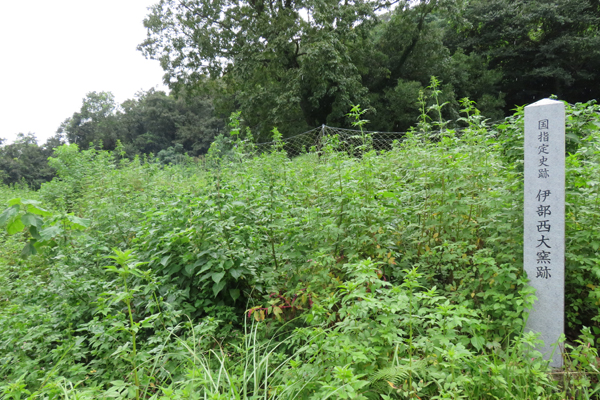
From the late Muromachi and into the Momoyama period, masters of the tea ceremony who had no wares or utensils for their art discovered aesthetic beauty in the practical wares of containers. Thus, by selecting water jars and flower vases for use in the tea ceremony, daily articles grew ever popular.Even at the production sites of Bizen pottery, the people there grasped this trend and began to make ‘Chato’ or ‘tea-wares’ for use in the tea ceremonies.
In the first half of the Momoyama Period, Sen no Rikyu who was one of the key proponents and developers of the tea ceremony, advocated that “the tea ceremony is the simple practice of boiling water and drinking tea” and preferred to do this in “a small rustic room laid with tatami mats, following the school of ‘directness in approach'”.What satisfied this preference was the Bizen ‘Mizusashi’ (water jar) and the flower vase.
Even though they constituted ‘Old Bizen’, wares from the Momoyama period were highly treasured as ‘Momoyama Bizen’ from the history of its background as mentioned above.
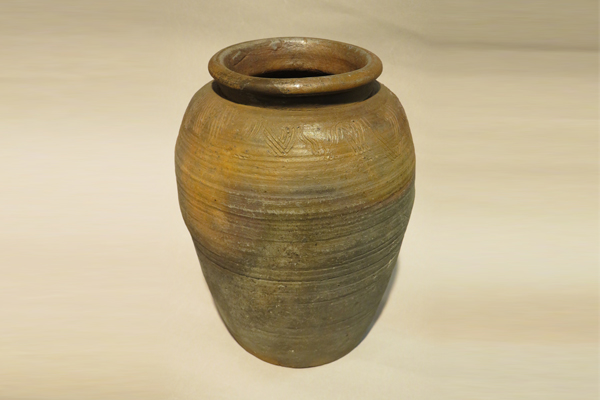
Old Bizen: Momoyama jar (owned by Gallery Mugen-an)
The famous feudal lord, general and pacifier Toyotomi Hideyoshi was also a great admirer of Bizen Pottery. At the great Kitano tea ceremony gathering that he hosted himself in the year of Tensho 15 (1587), he displayed Bizen water jars and flower vases alongside many other rare and famous wares.Hideyoshi ordered the production of a 2 koku (360 litre) Bizen jar to serve as his burial casket and serves to prove the extent of his extraordinary attachment to Bizen pottery.
Edo Period – Decline Period of Bizen Pottery
From around the Genwa year of the Edo period (1615-24), Bizen Pottery began to show signs of its prolonged decline.One of the reasons for this was that the patrons and proponents of the tea ceremony had changed and the people’s tastes moved towards more elegant and refined wares. People went so far as to say that such pottery as Bizen was crude and ugyly with its exposed reddish and earthy surface.
Hideyoshi’s expedition to Korea ended in faliure and because a number of generals took Korean potters back with them, there emerged a new type of pottery in the western regions of Japan. This was porcelain, or china. Amongst them, the porcelain of Arita had a smooth white surface that was totally different to the pottery that came before.
If one was to suggest that porcelain is the daughter of the city filled with style, then Bizen pottery woud be said to be the unrefined provincial daughter.Bizen pottery became the focus of ornaments that replaced the tea-wares that came before.
In order to resist porcelain, the technique of ‘Inbe-de’ was developed at Bizen kilns. This involved the application of slip from clay that had a relatively high iron content on the surface of fine wares and firing them. Once they had been fired, it would give a lustre to it like that of glazed wares or copperware. Furthermore, ‘Saikumono’ or figurative works that were combined with ‘Inbe-de’ techniques were devised.
Shizutani Pottery, White Bizen and Colored Bizen
Porcelain not only spread to Arita, but to Kyoto and Seto as well. Even Okayama domain could not resist making only ornamental wares so they took up the challenge of incorporating colours into pottery. This was know as Shizutani pottery.
Special Historical Site: Former Shizutani School
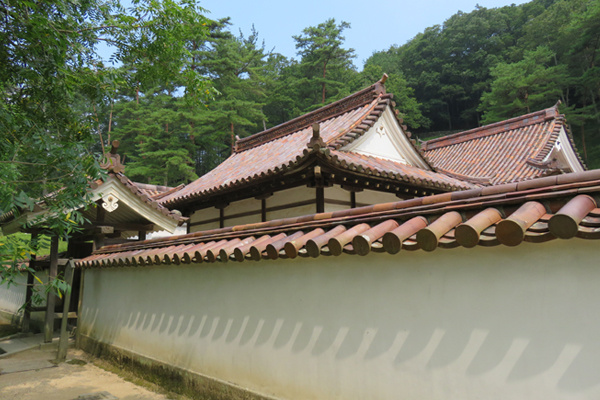
National Treasure : Auditorium of Former Shizutani School
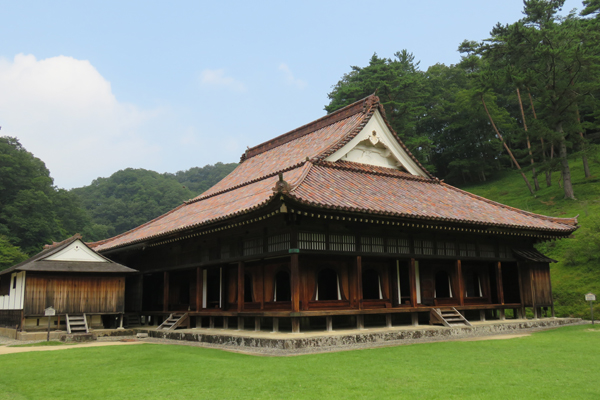
The impetus was when the feudal lord of Okayama domain, Ikeda Mitsumasa, ran an inspection of Kitani village in Wake, in the 6th year of Kambun (1666), and decided to construct Shizutani School.
The roof of Shizutani School (which is best known for being the oldest school in Japan to educate commoners), is laid with Bizen tiles even to this day. Back then the kiln where the tiles were fired was constructed 4 kilometres south of the school. It is said that Shizutani pottery began by using the ruins of the kiln to fire utensils used in rituals to pay reverence to the sacred deity that resided within the school, and that wares of both celadon and white types of porcelain remain.
Shizutani Pottery didn’t succeed commercially, but persisted in its challenge with coloured wares. At the beginning of the 18th century, figurative Bizen wares were fired at a high temperature with clear or white glazes on white clay, thus giving birth to the firing of ‘White Bizen’. Unfortunately this also did not prove to be successful. Furthermore, from the cooperation of leading painters from Okayama domain, colored Bizen works were made whereby painters of the Kano school used rock pigments to apply colour on bisque fired figures. However, these are rarely seen today.
Tempo Kiln
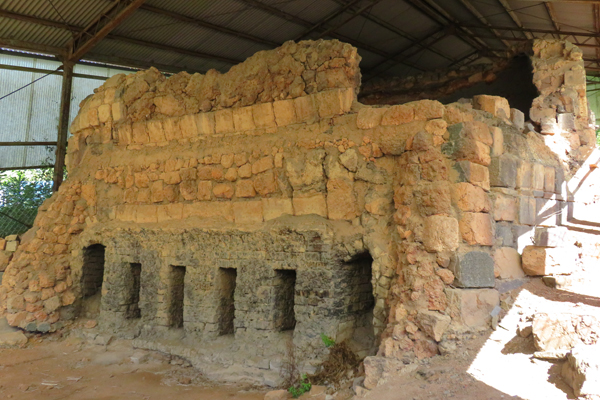
The demand for Bizen pottery declined to the extent that large kilns could not be fired. Drawing close to the Bakumatsu period in Tenpo 3 (1832), a vortex-fired, multi-chambered climbing kiln similar to those that fired porcelain was built.Back then this kiln was referred to as versatile because it could conveniently fire wares for the necessary time and amount. Because it was built during the Tenpo period, it was simply called the ‘Tenpo Kiln’.
Risen from the Sea’
Among the masterpieces of Bizen there are works given the title of ‘Risen from the Sea’.
The first ‘Risen from the Sea’ work was salvaged from the seabed in the offing of Naoshima in the 8th year of Taisho (1919) and it is said that it was placed alongside Seto wares in an shop in Yoshima.
The title ‘Risen from the Sea’ became famous when in the 15th year of Showa (1940), more were salvaged from the seabed in the offing of Naoshima. During a search based on a legend that “approximately 300 years ago, a ship carrying Bizen wares sailed from Katakami port and capsized in the Naoshima offing”, an astounding number of around 400 ‘Kobizen’ or ‘Old Bizen’ wares were recovered.
More recently, in the 52nd year of Showa (1977) Bizen wares estimated to be from the Muromachi period were recovered in large quantitites from the seabed of the offing in Utsumi town, Shodoshima. These can be viewed in the Okayama Prefectural Museum today.
Meiji and Taisho Periods
From the age of ‘civilization and enlightenment’ (bunmei kaika) in Meiji, the predominance of ideologies from European civilization flourished and the traditional culture of the Orient, particularly of Japan, was given considerably lower regard. Moreover, crude, earthy, undecorated wares such as those from Bizen were largely not looked back on anymore.
Furthermore, from the development of transportation systems such as the railroad, the glazed porcelain wares of Seto and Arita were able to be obtained at a reasonable price and this hastened the departure from Bizen wares.
The Tenpo Kiln used in the Bakumatsu period was still fired even in the Meiji period, but in the 6th year of Meiji (1873) a new communal kiln known as the ‘Meiji Kiln’ was built along with two small kilns referred to as the ‘site for the re-selction of pottery’. However, failing in its management as a company, it went bankrupt and was assimilated by a larger businness corporation.In the 20th year of Meiji (1877), personalized kilns were built and Bizen entered a new age of kilns that were significantly different to the communal kilns that were used continuously from the end of the Muromachi period.
Although it is difficult to imagine today, at this time the goods that were produced in the largest quantitites by kilns in Imbe were earthenware pipes and bricks.
Small models of earthenware pipes came to be made as early as the beginning of the Edo period. However, from the Meiji period there grew a demand for large quantitites and dozens of workers were called from Tokoname in Aichi prefecture to introduce the know-how for the manufacture of larger models of earthenware pipes. Furthermore, bricks also came to be fired thereafter.
Bizen Pottery during Wartime and Grenades
During the Pacific War, bronze and iron products such as bronze statues and hanging temple bells from various regions of Japan were contributed to the war effort.The Ninomiya Sontoku figures that were placed at the entrance of elementary schools were also contributed and in replacement, Bizen ceramic statues of Sontoku were made.
Furthermore, the hardness of Bizen wares was noted to be a formidable match for metal and there were orders from the military to use them to make hand-grenades.The fact that there was once an unfortunate and morbid age to which potters were forced to make weapons is something that must be told to succuessive generations.
Ancestry of Restoration of Bizen Pottery – Kaneshige Toyo
After World War 1, the Japanese economy reached a stage where it could stand equally alongside the nations of Europe and America.
In a cultural aspect, the decline of the Japanese cultural tradition from time immemorial as a result of worshipping the culture and civilization of the West has come to be reassessed with much enthusiasm.
One of the preferences of the newly emerging class of the wealthy born from the development of new industry is the tea ceremony, and the representative wares of this practice were teabowls, water jars and vases of the porcelain industry.
What’s more, the tea wares from Japan that they craved were Seto pieces from the Momoyama period, Mino, Iga, Karatsu and more importantly, Bizen wares.
For Bizen, there was one potter who who paid attention to the tea wares of the Momoyama period. His name was Kaneshige Toyo (1896-1967).
Toyo, who had once been famous in figurative handiwork decided to focus on the ‘return to Momoyama’ in his mid 30’s and began to observe famous wares of Momoyama Bizen as his samples.
However, because he wasn’t in an age where such things as exhibitions were held like they are today, he had to create links by calling on the lineages of ancient noble families and tea masters as well as businessmen. As a result of this, his companionship grew throughout the country. Out of them, the visit of Kitaoji Rosanjin and Osamu Noguchi to Toyo’s kiln in the 27th year of Showa (1952), was greatly influential for him.
Toyo thought it was necessary to embrace the tea ceremony in order to create truly great tea wares. In order to make them, he entered the Mushanokoji-Senke school of the eminent tea master Sen Soshu who had visited his kiln. By associating with this tea master who lived in Kyoto, Toyo was able to learn techniques for his tea wares which required a profound sense of delicacy.
In addition, Toyo thoroughly carried out research on the production of pottery and their effects from firing with his own kiln. The secret chambers of the climbing kiln that were discovered through trial and error, the loading of wares into the kiln through precise and thorough calculation and the stoking of the kiln itself are subjects that have been passed on down the generations.
In the 30th year of Showa (1955), the institution of ‘Holders of Important Intangible Cultural Property’, or better known as ‘Living National Treasure’ was established. Currently, there have been 4 pottery and ceramics related figures who have been designated ‘Living National Treasure’ and Toyo was designated as the very first in Bizen pottery in the 31st year of Showa (1956).
Thanks to Toyo’s existence, potters of the same generation were also greatly encouraged and from this, successive potters continued to thrive under his influence. As a result, potters pursue their art independently in Bizen and this is precisely the reason why it has not become an industrialized region.
Present Bizen Pottery
Bizen Pottery Festival
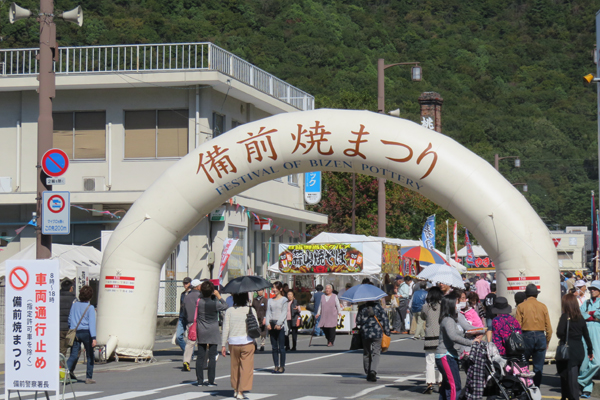
It is said that there are approximately 400 potters that fire Bizen wares around Imbe. Amongst them, foreign potters are also included.Although each of them have their own kiln, issues of smoke pollution and land price have made it difficult to establish new kilns in Imbe.
Led by the potters, the Bizen Pottery Festival is held on the 3rd Saturday and Sunday of October every year, and more than 100,000 admirers of pottery gather from all over Japan and Imbe is thronged with many people.


 日本語
日本語


